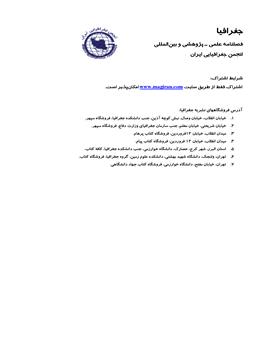Spatial Variability of Light Non-Aqueous Phase Liquid (LNAPL) in the Industrial Shahr-e-Rey Aquifer (South Tehran)
Subject Areas :
1 -
Keywords: Thickness of a light non-aqueous phase liquid (LNAPL), Relative density (LNAPL to water), Viscosity and Shahr-e-Ray industrial zone,
Abstract :
In the study area, Shahr-e-Ray industrial zone, south of Tehran, petroleum activities have led to aquifer pollution, so that in some parts the thickness of a light non-aqueous phase liquid (LNAPL) on the surface of the groundwater reaches to more than 20 meters. In this regard, estimation of thickness, density and viscosity of LNAPL, is of great importance to understand the quality of petroleum products of aquifer. Regarding the results of measurement, the range of LNAPL thickness in the aquifer vary between 2.73 to 14.305 m and the range of relative density (LNAPL to water) vary 0.78 to 0.83 and the range of viscosity vary 0.60 to 1.91 cst. According to the result in 10 wells the highest thickness of LNAPL is in the eastern and northeastern regions of the study area.
.
.
.
19. Couch, C(1999), Urban Renewal Theory and Practice, Macmillan, Basingstoke;
20. Daniele La Rosa∗, Riccardo Privitera, Luca Barbarossa, Paolo La Greca(2017), Assessing;
21. Ertan Tugce, Yakup Egercioglu(2016), Historic city Center Urban Regeneration: Case Of
Malaga and Kemerlta, Izmir, 2nd International Symposium New Metropolitan Perspective
Strategic Planning Spatial Planning Economic Programs and Decision Support tools, Through
the implementation Of Horizon/ Europe 2020. ISTH2020, Reggio Calabria(Italy)18-20,pp:601-
607;
22. Maskerey, Andrew (1989), Disaster Mitigation, a Community Based Approach. Oxfam.,1989;
23. Sally McDonald, Naglis Malys2, Vida Malienė(2009),Urban Regeneration For Sustainable
Communities, Journal Technological and economic development OF ECO NOM Y15/1.pp49-59;
24. spatial benefits of urban regeneration programs in a highly vulnerable urban context: A case
study in Catania, Italy, journal Landscape and Urban Planning, 157,pp:180-192;
25. Veland. H., Aven, T (2013), Risk communication in the light of different risk perspectives,
Reliability Engineering and System Safety 110,pp: 34–40.


